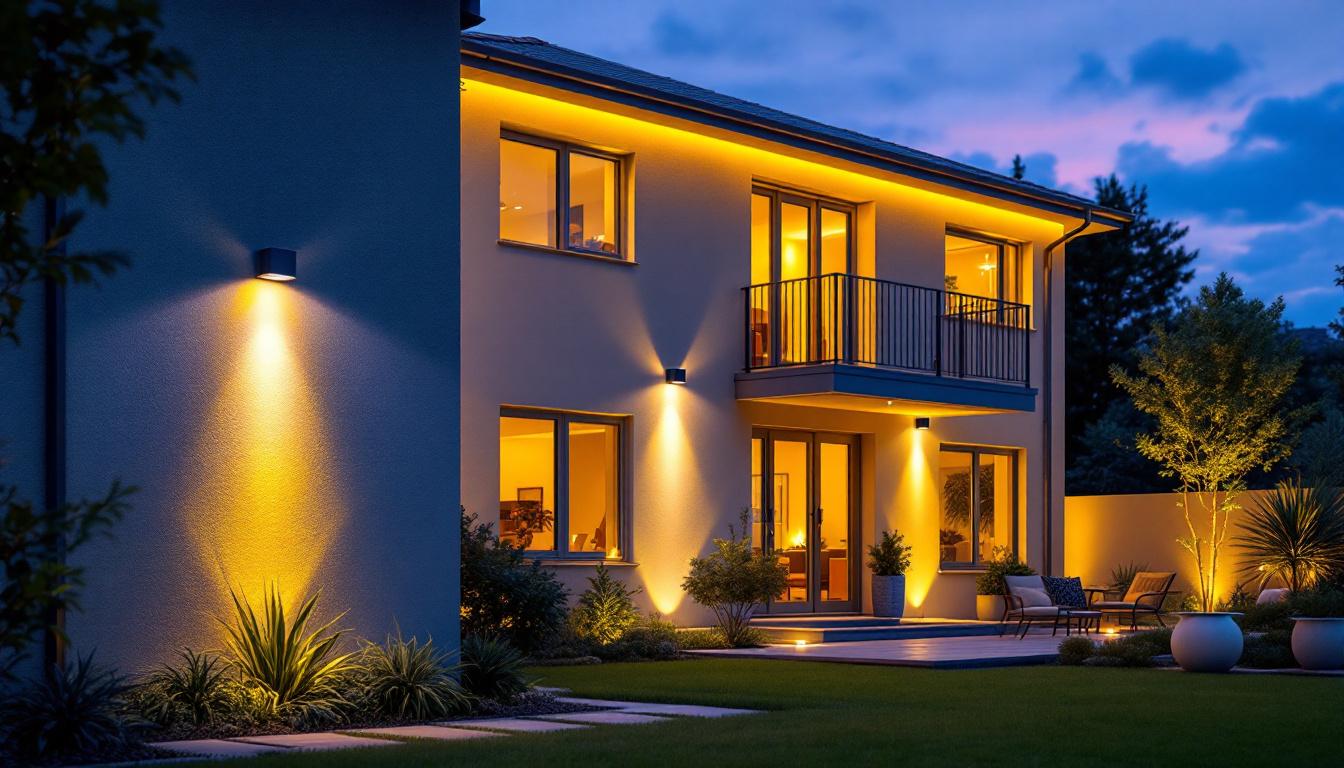
In the realm of outdoor lighting, the integration of light sensors has become a pivotal aspect of modern installations. Clients increasingly expect lighting contractors to possess a comprehensive understanding of these devices, as they contribute significantly to energy efficiency, convenience, and safety. This article delves into the essential knowledge that contractors should have regarding outdoor lighting light sensors, ensuring that they can meet and exceed client expectations.
Light sensors, often referred to as photocells or photoelectric sensors, are devices that detect ambient light levels and adjust outdoor lighting accordingly. They play a crucial role in automating lighting systems, ensuring that lights turn on at dusk and off at dawn without manual intervention. This automation not only enhances user convenience but also optimizes energy consumption. By utilizing light sensors, property owners can significantly reduce their electricity bills while contributing to environmental sustainability through decreased energy usage.
There are several types of light sensors available on the market, each with its unique features and applications. The most common types include:
Understanding the differences between these types of sensors is crucial for lighting contractors. Clients may have specific needs based on their property, and being able to recommend the right type of sensor can significantly enhance client satisfaction. Furthermore, as technology evolves, new features such as daylight harvesting and integration with other smart devices are becoming increasingly popular, allowing for even greater efficiency and control over lighting systems.
Light sensors operate on the principle of photoconductivity, where the electrical resistance of a material changes in response to light exposure. A typical light sensor consists of a photodiode or phototransistor that generates a small voltage when exposed to light. This voltage is then used to control a relay, which in turn switches the lighting circuit on or off. The sensitivity of these sensors can often be adjusted, allowing for fine-tuning based on specific environmental conditions or user preferences.
For contractors, understanding this basic mechanism allows them to troubleshoot issues effectively. For instance, if a light sensor fails to operate as expected, knowing how it functions can help pinpoint whether the problem lies in the sensor itself, the wiring, or the connected lighting fixtures. Additionally, familiarity with the installation process and potential obstacles, such as obstructions that could block light from reaching the sensor, can save time and resources during the setup. Properly installed and calibrated light sensors can lead to a seamless integration of lighting systems that not only meet the aesthetic needs of a property but also enhance its overall functionality.
Clients have specific expectations when it comes to outdoor lighting installations, particularly concerning the use of light sensors. Meeting these expectations requires a combination of technical knowledge, effective communication, and a commitment to quality service.
One of the primary reasons clients opt for light sensors is the promise of energy efficiency. Homeowners and business owners alike are increasingly conscious of their energy consumption and its impact on both the environment and their utility bills. Lighting contractors should be prepared to explain how light sensors can significantly reduce energy usage by ensuring that lights are only on when necessary.
Moreover, clients expect contractors to recommend energy-efficient lighting options, such as LED fixtures, which, when combined with light sensors, can lead to substantial savings over time. Providing clients with data or case studies that illustrate potential savings can enhance their confidence in the proposed solutions. Additionally, discussing the long lifespan of LED lights compared to traditional bulbs can further underscore the economic advantages. Clients appreciate understanding how their investment not only benefits their immediate financial situation but also contributes to a more sustainable future.
Clients expect outdoor lighting systems to function reliably, especially in varying weather conditions. This means that lighting contractors must be knowledgeable about the environmental factors that can affect sensor performance. For instance, rain, snow, or debris can obscure sensors, leading to malfunctioning lights.
Contractors should also educate clients about the importance of regular maintenance. Offering a maintenance plan that includes cleaning sensors and checking connections can reassure clients that their lighting systems will remain functional and efficient over time. Furthermore, discussing the installation of weather-resistant fixtures can alleviate concerns about durability, especially in regions prone to severe weather. Clients often appreciate learning about advancements in technology, such as smart sensors that can adapt to changing conditions, ensuring optimal performance regardless of the environment.
In addition to reliability, clients are increasingly interested in the integration of smart home technology with their outdoor lighting systems. This includes features like remote control via smartphone apps or voice-activated systems that allow for greater convenience and customization. Educating clients on how these modern solutions can enhance their overall experience can set a contractor apart, demonstrating a commitment to not just meeting but exceeding client expectations. By providing insights into the latest trends and innovations in outdoor lighting, contractors can foster a sense of trust and excitement about the potential of their installations.
Proper installation of light sensors is critical to their performance. Lighting contractors should be well-versed in the best practices for installing these devices to ensure optimal functionality and longevity.
The placement of light sensors can significantly influence their effectiveness. Contractors should advise clients on the best locations for sensors, taking into account factors such as shading from trees or buildings, potential obstructions, and the desired coverage area for lighting.
For instance, placing a sensor too close to streetlights or other artificial light sources can cause it to malfunction, leading to unnecessary energy consumption. Educating clients on these considerations can prevent future issues and enhance the overall satisfaction with the lighting installation.
Proper wiring is essential for the effective operation of light sensors. Contractors must ensure that all connections are secure and that the wiring is suitable for outdoor use. This includes using weatherproof materials and protecting connections from moisture and corrosion.
Additionally, understanding the electrical requirements of the chosen lighting fixtures is crucial. Contractors should be prepared to explain how different fixtures may affect the performance of the light sensor and ensure compatibility during the installation process.
As technology evolves, so do the features available in outdoor lighting light sensors. Clients may expect contractors to be knowledgeable about these advancements and how they can enhance their lighting systems.
With the rise of smart home technology, many clients are interested in integrating their outdoor lighting systems with home automation platforms. Lighting contractors should be familiar with how light sensors can be connected to smart home systems, allowing clients to control their outdoor lighting remotely or set specific schedules.
Being able to recommend compatible smart sensors and explain their functionality can set a contractor apart in a competitive market. Clients appreciate contractors who can provide solutions that align with their tech-savvy lifestyles.
Adaptive lighting solutions are becoming increasingly popular, allowing outdoor lighting systems to adjust based on real-time conditions. This can include features such as dimming lights during twilight or brightening them when motion is detected.
Contractors should be prepared to discuss the benefits of these advanced systems, including enhanced security and energy savings. Clients may be particularly interested in how adaptive lighting can improve the safety of their properties while also providing aesthetic appeal.
Despite the benefits of light sensors, there are common challenges that contractors may encounter during installation and maintenance. Understanding these challenges and having effective solutions at hand is essential for providing exceptional service.
One of the most common issues with light sensors is malfunction due to environmental factors or electrical problems. Contractors should be able to diagnose issues quickly, whether they stem from dirt accumulation on the sensor, faulty wiring, or a defective unit.
Providing clients with guidance on how to troubleshoot minor issues can empower them and reduce service calls. For instance, advising clients to check for obstructions or clean the sensor periodically can help maintain optimal performance.
Educating clients about the functionality and maintenance of their lighting systems is crucial. Many clients may not fully understand how light sensors work or the importance of proper placement and maintenance.
Contractors should take the time to explain the operation of light sensors during the installation process and provide written materials or resources for clients to reference later. This proactive approach can lead to greater client satisfaction and fewer misunderstandings in the future.
Outdoor lighting light sensors are an integral part of modern lighting installations, offering clients convenience, energy efficiency, and enhanced safety. Lighting contractors must equip themselves with a thorough understanding of these devices, including their types, functionality, installation best practices, and the latest technological advancements.
By meeting and exceeding client expectations regarding light sensors, contractors can build a reputation for reliability and expertise in the field. Ultimately, a well-informed contractor can provide clients with tailored solutions that enhance their outdoor spaces while ensuring optimal performance and efficiency.
In a competitive market, staying updated on the latest trends and technologies in outdoor lighting will not only benefit contractors but also create lasting relationships with clients who appreciate knowledgeable and professional service.
Ready to elevate your outdoor lighting installations with the finest light sensors and fixtures? Look no further than LumenWholesale. We provide contractors with exceptional, spec-grade lighting products at the most competitive wholesale prices. Our commitment to quality and affordability ensures that you have access to the best lighting solutions without the burden of inflated costs. Plus, with the convenience of free shipping on bulk orders, you can trust that you’re getting premium value with every purchase. Enhance your outdoor lighting projects today by visiting Wholesale Lighting at the Best Value and discover the difference that LumenWholesale can make for your business.

Discover how top lighting contractors distinguish themselves with expert installation of ceiling can light covers.

Discover the common pitfalls lighting contractors face with outdoor LED installations and learn how to avoid them.

Discover the essential facts about universal light mounting brackets that every lighting contractor needs to know.

Discover essential tips for lighting contractors to prevent common pitfalls when working with locked plugs.